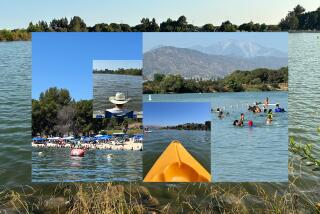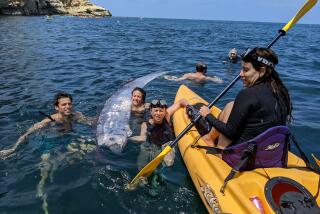New Aquarium of the Pacific exhibit to honor the steelhead
- Share via
Steelhead trout once packed the natural pools of Southern California’s spawning rivers — that is, until the waterways were transformed into concrete drainage canals in the 1930s to protect the burgeoning flatlands from flooding.
The last steelhead in the Los Angeles River was a 25-incher caught off a bridge in Glendale in 1940, two years after that stretch was paved. Today, the region’s steelhead population hovers around 500 — 10% of what it was seven decades ago.
“The good news is that steelhead are remarkably resilient if given half a chance,” Jerry Schubel, president and chief executive of the Aquarium of the Pacific in Long Beach, said last week as crews were installing plumbing and temperature controls in an exhibit he said was designed to “reveal some of the secrets of this fish and inspire conservation.”
The $850,000 display, going up a few hundred yards from the mouth of the L.A. River, is scheduled to open May 23. Its centerpiece is a row of 20-foot-long aquariums that represent the steelhead’s journey from mountain streams to the Pacific Ocean.
“Even in the best of times, to be a steelhead in Southern California was to persist in some of the most daunting river systems imaginable for a spawning species,” said Tom Tomlinson, an expert on the cultural history of Southern California steelhead. “They were prone to abrupt shifts from dry and dusty corridors to raging torrents.”
The steelhead — a distant cousin of the salmon — managed to hold on here despite assaults on its habitat that included the damming of rivers as well as urban development and pollution.
“Incredibly, they still show up to spawn in places such as Ballona Creek, Malibu Creek and the mouth of the San Gabriel River,” Tomlinson said.
The species, known scientifically as oncorhynchus mykiss, begins life as a native rainbow trout. For still-unknown reasons, some migrate to the ocean and become steelheads after undergoing physical changes that allow them to return to spawn over freshwater gravel beds.
Steelheads are slimmer, more silver in color and larger than the rainbows that spend their lives in fresh water.
Initially, the aquarium’s exhibit will pulse with hundreds of rainbow trout. “Eventually we may experiment with the chemistry of the water in hopes of watching some of these fish morph into steelheads,” Schubel said.
The goal is to promote public support for restoration projects needed to turn local rivers back into “steelhead freeways,” he said.
A separate exhibit — also scheduled to open May 23 — will feature a breeding pair of Guam kingfishers, one of the most endangered animal species in the world. There are only 134 of the birds left, all of them in captivity.
Brown tree snakes, which arrived in Guam after World War II as stowaways on military ships, devoured most of the birds native to that Pacific island.
“These birds had no time, biologically speaking, to learn to evolve evasive behavior patterns,” said Rob Mortensen, the aquarium’s assistant curator of mammals and birds.
“We’re excited about being participants in efforts to one day release captive-bred kingfishers into the wilds,” he said. “Guam, however, is out of the question. Too many snakes there.”
Twitter: @LouisSahagun
More to Read
Sign up for Essential California
The most important California stories and recommendations in your inbox every morning.
You may occasionally receive promotional content from the Los Angeles Times.











